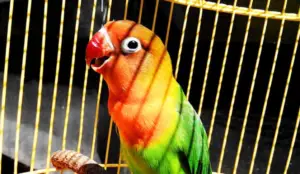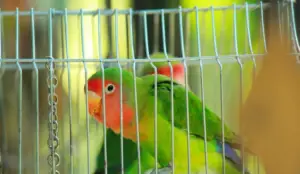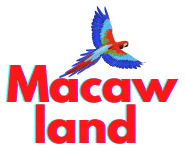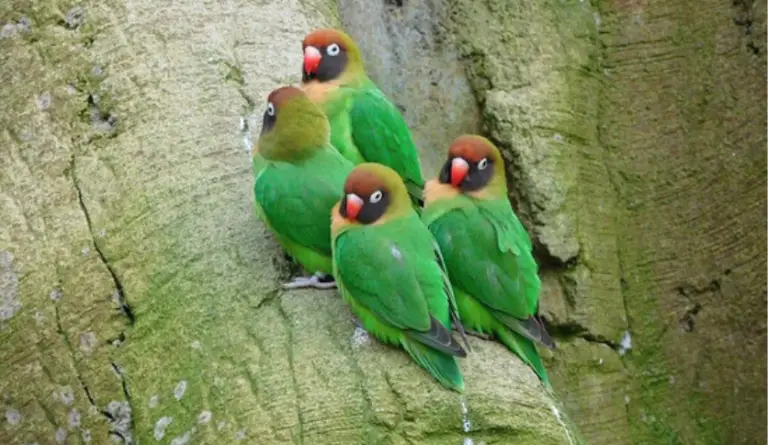When you’re thinking about bringing a new pet into your home, it’s important to consider the cost, and this is especially true for lovebirds. These charming and colorful birds are a popular choice for many people, but before you decide to get one, you might wonder, “How much does a lovebird cost?” In this introduction, we’ll explore the various factors that can affect the price of a lovebird, including their breed, age, where you buy them from, and the additional expenses for their care and upkeep.
Understanding these aspects will help you make an informed decision and ensure that you’re ready to welcome a lovebird into your life.
What Factors Influence the Price of a Lovebird?
he cost of a lovebird depends on its type, age, health, and how rare it is.
When you’re looking to buy a lovebird, you’ll notice that not all lovebirds cost the same. This difference in price is mainly because of a few key factors: the bird’s species, its age, how healthy it is, and how rare or special it is.
Species of the Lovebird
Lovebirds come in various types, each with its own price range. For example, Peach-faced lovebirds, which you see quite often, are usually cheaper. But if you’re looking at Black-cheeked lovebirds, which aren’t as common, you’ll probably have to pay more. It’s like shopping for cars: a more common model is less expensive than a rare one.
Age of the Lovebird
The age of the lovebird plays a big role in its price. Generally, younger lovebirds are cheaper than older ones. This might be because younger birds are more easily trainable and can adapt better to new environments. However, older birds have their perks too. They often come with known health histories, so you know exactly what you’re getting. It’s a bit like choosing between a brand-new puppy and an older, more mature dog.
Health of the Lovebird
A lovebird’s health is a big deal when it comes to how much it costs. A healthy lovebird, with a vet’s certificate to prove it, will usually cost more. Think of it like buying a used car – you’d pay more for one that’s in top-notch condition and has all its service records, right?
Rarity and Special Characteristics
Finally, if a lovebird has rare features, like an unusual color pattern, or if it’s from a special pedigree line, its price will go up. These are the lovebirds that stand out in the crowd – kind of like limited-edition items in a store.
Initial Costs: Purchasing Your Lovebird

Expect to pay anywhere from $50 to $200 for your lovebird, depending on the abovementioned factors.
When purchasing a lovebird, you have several options: breeders, pet stores, or rescue centers. Breeders might offer birds with known backgrounds at a higher price, while pet stores generally provide more affordable options. Rescue centers are an excellent choice for those looking to adopt, often involving a smaller adoption fee. Remember, the initial purchase is just the beginning. Ensuring that your new companion is healthy and happy will involve more costs down the line.
Essential Supplies for Your Lovebird and Their Costs
Essential supplies include a cage, food, toys, and more, which can total around $100 to $300.
A sturdy cage is the most significant investment, potentially costing between $50 and $200. It should be spacious and safe for your lovebird. You’ll also need to budget for high-quality bird food, toys, perches, and bedding. While these costs can add up, remember that some of these are one-time purchases or long-lasting investments.
Ongoing Care Expenses for Lovebirds
Every month, you might spend about $20 to $50 on your lovebird’s food and grooming, with yearly vet visits adding more to your budget.
Caring for a lovebird involves more than just love and attention; it also means being ready for the regular costs that keep them healthy and happy. Let’s break down these ongoing expenses to help you plan your budget effectively.
Regular Food Costs
The most frequent expense for your lovebird will be their food. Depending on what you choose to feed them, this cost can vary. Lovebirds enjoy a diet that includes seeds, pellets, fruits, and vegetables. High-quality pellets are a great base for their diet and can cost around $10 to $20 per bag. Remember, though, a little goes a long way with these small birds! Fresh fruits and vegetables are essential too, but they’re often part of your regular grocery shopping, so they might not significantly bump up your bill.
Grooming Needs
Lovebirds, like many pets, need grooming to stay healthy. This includes nail clipping and feather trimming. While you can learn to do this at home, many lovebird owners prefer to have it done by a professional to avoid any accidents. Professional grooming might only be needed a few times a year and can cost around $10 to $20 per session.
Veterinary Care
Regular vet checkups are vital for your lovebird. These visits ensure your bird is healthy and can help catch any issues early. Typically, an annual vet visit for a lovebird can range from $50 to $100. The cost can vary depending on where you live and the specific services needed. Remember, this does not include any unexpected illnesses or emergencies, which can add to the cost.
Budgeting for Your Feathered Friend
Setting aside a small amount each month can help you manage these ongoing costs without stress. It’s always a good idea to have a little extra saved up, too, in case of unexpected vet bills. By planning ahead and understanding these ongoing expenses, you can ensure that your lovebird remains a happy and healthy companion.
Unexpected Costs in Lovebird Ownership
Be prepared for unforeseen expenses like emergency medical care, which can cost hundreds of dollars.
Owning a pet always comes with potential unexpected expenses. For lovebirds, these could include emergency veterinary visits due to illness or accidents, which can be costly. Additionally, behavioral or health issues might require special treatments or modifications in their living environment.
Budgeting Tips for Potential Lovebird Owners

Owning a lovebird is a joy, but it also means you need to be smart with your money. It’s not just about how much you spend initially, but also how you plan for both the regular costs and those surprises that might pop up along the way. Here’s how you can do that without cutting corners on the care your feathered friend deserves.
Start with a Clear Budget
First things first, know what you’re getting into. Start by jotting down all the expected expenses: the bird itself, cage, food, toys, and vet visits. These are your basics. But also remember, just like us, birds can have unexpected needs. Maybe a trip to the vet outside the regular check-up or a toy that needs replacing. It’s smart to set aside a little extra for these moments.
Saving on Supplies Without Sacrificing Quality
Here’s a neat trick: buy supplies in bulk. This works great for things like food and bedding that you’ll always need. Bulk buying often comes cheaper. But, keep an eye on quality. It’s no use buying lots of something that isn’t good for your lovebird.
Also, keep your eyes peeled for sales and discounts. Pet stores often have deals, especially if you’re part of a loyalty program. And don’t forget online shopping – sometimes the best deals are just a click away.
DIY and Upcycling
Get creative! There’s a lot you can do yourself. For example, toys don’t always have to come from a store. Safe household items can be just as fun for your bird. Things like paper rolls, unscented tissues, or even simple wooden spoons can be great entertainment. Just make sure they’re safe and free from any harmful chemicals.
Regular Check-Ups Are Cheaper in the Long Run
Never skimp on vet visits. It might be tempting to skip a check-up to save money, but regular health checks can catch issues early, saving you big bucks on potential future treatments. Think of it as an investment in your bird’s health and your peace of mind.
Plan for the Long-Term
Remember, lovebirds can live for quite a few years. This isn’t a short-term commitment. Planning ahead financially for the entire lifespan of your bird is crucial. This includes setting aside funds for their care as they age, which might involve more medical attention.
Insurance – A Safety Net Worth Considering
Pet insurance for birds is a thing and it can be a lifesaver in covering unexpected medical expenses. Do your research and see if it’s right for you. It might add a bit to your regular expenses, but it can drastically cut down the costs in case of an emergency.
The True Cost of Lovebird Ownership: Is It Worth It?
While owning a lovebird can be a financial commitment, the joy and companionship they bring often outweigh the costs.
Considering all the financial aspects, owning a lovebird is indeed a significant commitment. It’s not just about the monetary investment but also the time and emotional involvement. For many, the companionship and joy that these charming birds bring make every penny worth it.
FAQ about lovebird cost
How much should I expect to spend in the first year of owning a lovebird?
In the first year, you might spend around $200 to $500, including the cost of the bird, initial supplies, and veterinary care.
Are there any hidden costs in lovebird care?
Yes, potential hidden costs include bird-sitting services, travel cages, and special dietary needs.
Can I reduce the cost of owning a lovebird without compromising their well-being?
Yes, by buying supplies in bulk, choosing cost-effective yet nutritious food, and doing some grooming tasks at home.
What is the lifespan of a lovebird and how does it impact cost?
Lovebirds can live up to 15 years, meaning a long-term financial and care commitment.
Is pet insurance worth it for a lovebird?
Pet insurance can be beneficial for covering unexpected medical expenses, but weigh the costs against the likelihood of use.
Conclusion
In conclusion, when considering bringing a lovebird into your life, it’s important to ask, “How much does a lovebird cost?” This question isn’t just about the initial price tag of these colorful, charming birds. It’s also about understanding the ongoing care costs, from feeding and housing to healthcare and entertainment. Budgeting wisely for expected and unexpected expenses ensures you can provide a happy, healthy home for your feathered friend without breaking the bank. Remember, owning a lovebird is a commitment, both emotionally and financially.
By planning ahead and being mindful of expenses, you can enjoy the delightful experience of lovebird ownership, filled with joy and vibrant companionship.

Hi, I’m Regina Rios. Just another bird lover who loves to share knowledge from personal experience. I’ve grown up with pet birds since childhood as my mommy also loves birds. As I can’t pet many birds in open air in my house as my mom does; I created my first bird cage on my rooftop using wood, copper wire, and a metal shed in 2018 and start collecting pet birds. Now, I have so many pet birds such as Macaws, Parrot, Cockatiel, Parakeet, and others. Not only that, if I see natural birds are injured I keep them in my house until they get well. Now, my hobby becomes my income source as my home birds have babies and I sell them to birds lover like mine. I’ve created this blog to inspire others bird owners by sharing my personal knowledge. Good Luck!


